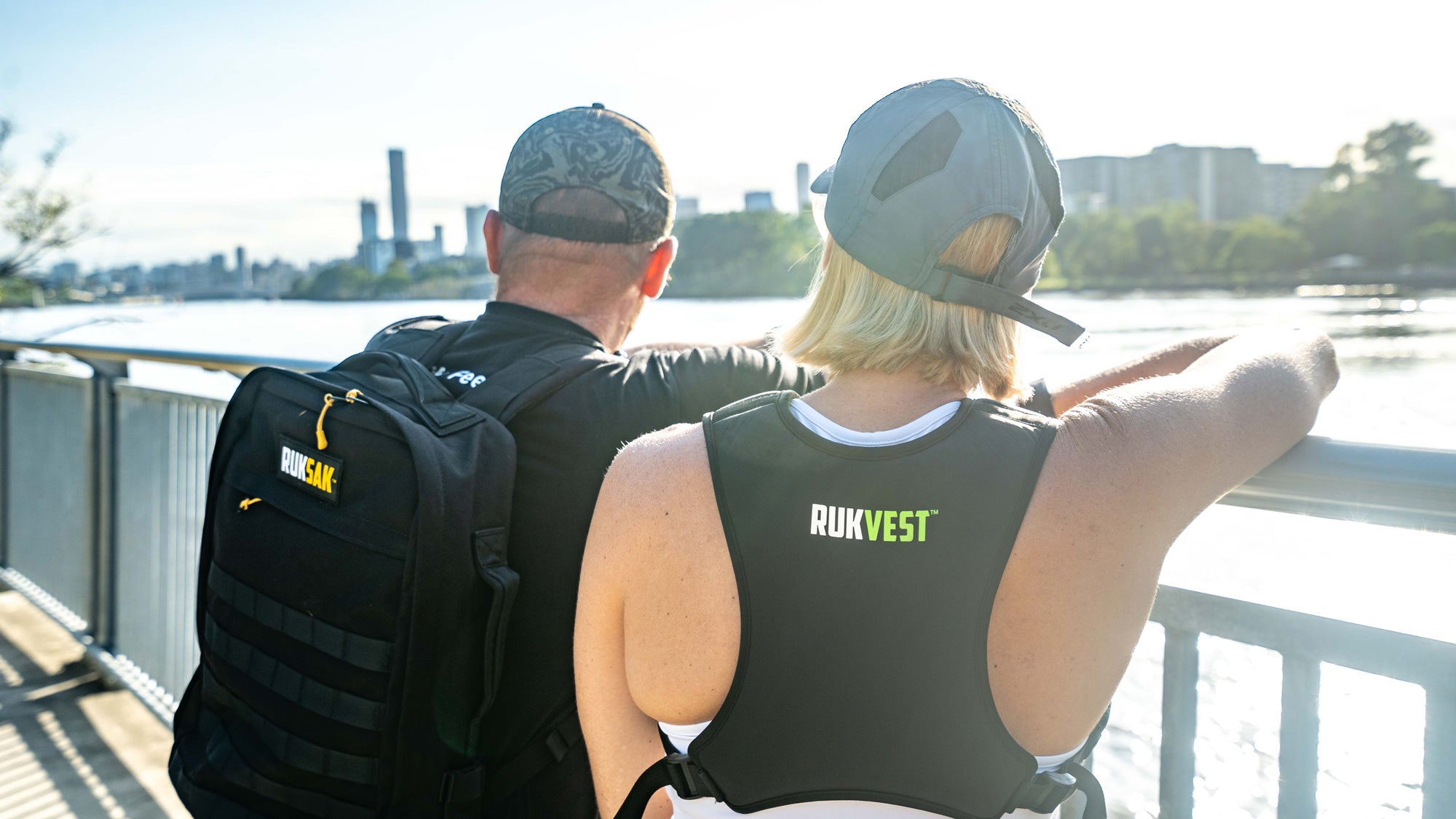
What is Rucking?
Rucking simply means walking with a weighted backpack or vest. It started in the military, where it’s used to build strength, endurance, and resilience with a far lower injury risk than running.
For everyday people, rucking is:
- Simple
- Joint-friendly
- Beginner-friendly
- Effective for weight loss, fitness, and posture
Whether you’re a fitness enthusiast looking for a new challenge or a beginner seeking an accessible way to get fit, rucking offers a versatile and rewarding workout.
RUKSAK vs RUKVEST – Which Should You Choose?
When deciding between the RUKSAK and the RUKVEST, it’s all about how you plan to use the gear and your fitness goals. Here’s a quick comparison to help you choose:

RUKVEST: Weighted Vest Using Weighted Gel
The RUKVEST is the grab-and-go option, ideal for those looking for convenience and shorter workouts:
- Fixed Weight: The RUKVEST comes as a fixed weight (available in 3kg, 5kg, 8kg or 11kg), which simplifies the process—no need to adjust the load. It’s perfect for activities like short walks, yard work, or even cleaning the house!
- Comfort and Affordability: Made from innovative weighted gel technology, the RUKVEST is designed for ultimate comfort, with weight evenly distributed between the front and back, ensuring better balance and ease of movement during workouts.
- Everyday Use: Since it’s lightweight and easy to wear, the RUKVEST is ideal for quick, everyday activities without the need for extended prep.
Why people choose RUKVEST
- Grab-and-go fixed weight: 3kg, 5kg, 8kg or 11kg
- Extremely comfortable thanks to evenly distributed weighted gel
- Perfect for short walks, housework, quick movement snacks
- No setup, no weight adjustment

RUKSAK: Adjustable Weight Backpack
The RUKSAK is perfect for those who want flexibility and versatility in their rucking experience. Here are the key benefits:
- Adjustable Weight: The RUKSAK allows you to gradually increase the weight by adding RUKBRIKs, which makes it ideal for users who want to tailor their workouts and progress over time.
- Adventure-Ready: With its rugged design and accessory options like hydration packs and waist belts, the RUKSAK is great for longer rucks and hikes. You can also add a laptop sleeve for work trips or use it as a home workout tool.
- Comfort for Long Rucks: The RUKSAK’s design ensures comfort, even with added weight, making it the preferred choice for extended use.
Why people choose RUKSAK:
- Adjustable weight using RUKBRIKs
- Great for progression over time
- Rugged design built for adventureCan be
- used as a travel or work pack
- Very comfortable even at higher loads
How to Start Rucking
(Beginner-Friendly Guide)
2. Basic Rucking Technique
Packing the Rucksack: Most designed for purpose rucksacks will have dedicated pockets to place their designed weights. If you are packing a backpack with weight, try to place the heaviest items closest to your back to distribute the weight evenly and anchor them in to reduce movement. Also consider using padding, like a towel or foam, to protect your back from hard or sharp objects.
Adjusting the Straps: You want to ensure the backpack fits snugly and is comfortable, with the weight ultimately resting on your hips rather than your shoulders. To do this adjust the shoulder straps, hip belt and chest straps (if your pack has them) to give you the best rucking experience.
Posture: Stand tall with a slight lean forward, keeping your back straight and core engaged. Avoid hunching over or leaning too far back. The great thing about rucking is that it will improve your posture over time, particularly if you spend a lot of time hunched over screens.
Warm-Up: Being you are just walking, just start at a pace that’s comfortable to get everything warmed up.
Distance and Duration: Start with shorter distances to start and gradually increase as you build strength and endurance. Aim for a pace that feels challenging but sustainable for the distance you aim to travel.
3. Rucking Safety and Injury Prevention
Listen to your body
Recognising the difference Between Pain vs. Discomfort: Pay attention to any signs of discomfort or pain. Rucking should be challenging but it should not be harmful, so try and learn to distinguish between normal muscle fatigue and what could be potential injuries.
Taking Breaks: Take regular breaks during your ruck when you feel like you need to rest, hydrate, and assess your condition. Don’t ever push through severe pain or discomfort.
Proper Recovery
Rest Days: Allow time for rest and recovery between rucking sessions to prevent overuse injuries. Listen to your body and take rest days as needed.
Stretching and Foam Rolling: Incorporate stretching and foam rolling into your routine to improve flexibility, reduce muscle soreness, and prevent injuries.
Hydration and Nutrition
Staying Hydrated: Drink water regularly before, during, and after your ruck to stay hydrated. Some rucksack brands have a hydration bladder inside them for easy access or you can carry a water bottle in your pack for when you need it.
Fueling Your Body: It will make you a better rucker, and a better human if you eat a balanced diet with as minimal ultra processed foods as possible.
Consulting Professionals
Medical Advice: If you’re new to exercise or have any health concerns, make sure you consult your G.P before starting a rucking program.
Professional Guidance: Consider working with a personal trainer or exercise physiologist to ensure proper form and technique, especially if you have any pre-existing conditions or injuries.
Rucking FAQs
Here you will find answers to some of the most frequently asked questions that land in our inbox.
Will rucking build muscle?
Yes! Rucking builds muscle by combining the benefits of resistance training and cardio in a single activity. When you walk with a weighted backpack (a ruck), your body engages multiple muscle groups, particularly in the legs, back, shoulders, and core, to carry the load and maintain balance. The added weight increases the intensity of the workout, forcing your muscles to work harder with each step, which leads to muscle strengthening and growth over time. Unlike traditional cardio exercises, which primarily focus on endurance, rucking also applies resistance to the body, challenging muscles in a way that promotes hypertrophy (muscle growth) and improved muscular endurance. This combination helps build lean muscle mass while improving overall fitness.
Why are rucking backpacks so expensive?
Rucking backpacks are expensive due to their durability and specialised design. They are made from high-quality materials like reinforced nylon and tough stitching to handle heavy loads and frequent use. Ergonomic features, such as padded straps and weight-distribution systems, ensure comfort and minimise strain, requiring advanced engineering. Their versatility for rucking, hiking, and travel also adds value, making a rucking backpack a long-term investment.
Is rucking better than running?
Whether rucking is better than running depends on your fitness goals. Rucking provides a combination of cardiovascular exercise and strength training by adding weight, which engages more muscle groups, particularly in the legs, core, and upper body, leading to muscle growth and improved endurance. It's also lower-impact on the joints compared to running, making it a good option for those who want a challenging workout without the wear and tear of high-intensity cardio. However, running may burn more calories in a shorter time and is better for improving cardiovascular capacity and speed. Ultimately, rucking is better for those seeking a full-body workout and functional strength, while running is more effective for maximising calorie burn and cardiovascular endurance.
How much weight should I carry when rucking?
The amount of weight you should carry when rucking depends on your fitness level and experience. For beginners, it's recommended to start with 5-10% of your body weight. For example, if you weigh 70 kg, you might begin with 3-7kg in your ruck to allow your body to adjust to the added load and avoid injury. As you gain strength and endurance, you can gradually increase the weight. Experienced ruckers typically carry between 14-23 kg, depending on the intensity of their workout and fitness goals. Always prioritise good form and listen to your body to avoid overstraining.
Why is rucking good for you?
Rucking is good for you because it combines cardiovascular exercise with strength training, offering a full-body workout that builds muscle, improves endurance, and enhances functional fitness. Carrying weight while walking engages your legs, core, back, and shoulders, helping to increase muscle strength without the high impact of running, making it gentler on your joints. It also boosts cardiovascular health, burns calories, and improves posture. Rucking mimics real-life movements, making it a practical way to improve overall fitness and perform daily tasks with greater ease and resilience. You can read more about the benefits of rucking here.
Can I lose weight rucking?
Yes, you can lose weight by rucking. Rucking is an effective form of cardiovascular exercise that burns calories while also building muscle, which helps boost your metabolism. Since it combines walking with the added resistance of carrying weight, rucking increases the intensity of your workout, leading to higher calorie expenditure compared to regular walking. Additionally, the muscle-building aspect of rucking helps increase long-term fat burning, as muscle tissue requires more energy to maintain than fat. By incorporating rucking into your routine, along with a healthy diet, you can create a calorie deficit and support weight loss.
Where can I find rucking events near me?
Promoting local events and organising rucking based activities is a significant part of our efforts to establish rucking as a recognised activity in Australia and worldwide. In Australia, the most effective way to connect with fellow ruckers is through a parkrun. It’s free, and you can walk, run, or ruck at 496 locations across the country. Click here to find events in your area.
You can also check our @getrukd facebook page to see if there are any clubs in your area or start one of your own.
Is rucking safe?
Yes, rucking is generally safe when practiced correctly, but it’s important to consider a few guidelines. Start slowly by using lighter weights and shorter distances to allow your body to adapt. Invest in a well-fitted rucking backpack and supportive footwear to minimise the risk of injury. Maintain good posture while rucking to avoid strain on your back and joints, and be mindful of any discomfort; if pain persists, rest and consult a healthcare professional if needed. Staying hydrated is also crucial, especially in warm weather. By following these tips, you can enjoy rucking as a safe and effective fitness activity.
Can I make my own RUKSAK?
You certainly can start rucking by putting weights in your average backpack, but at some point you will want to invest in a sturdy, durable rucksack designed to carry heavy loads. Look for features like padded shoulder straps and back, hip belts, thermoplastic back plate, reinforced stitching and secure pockets for the weights to sit in.







